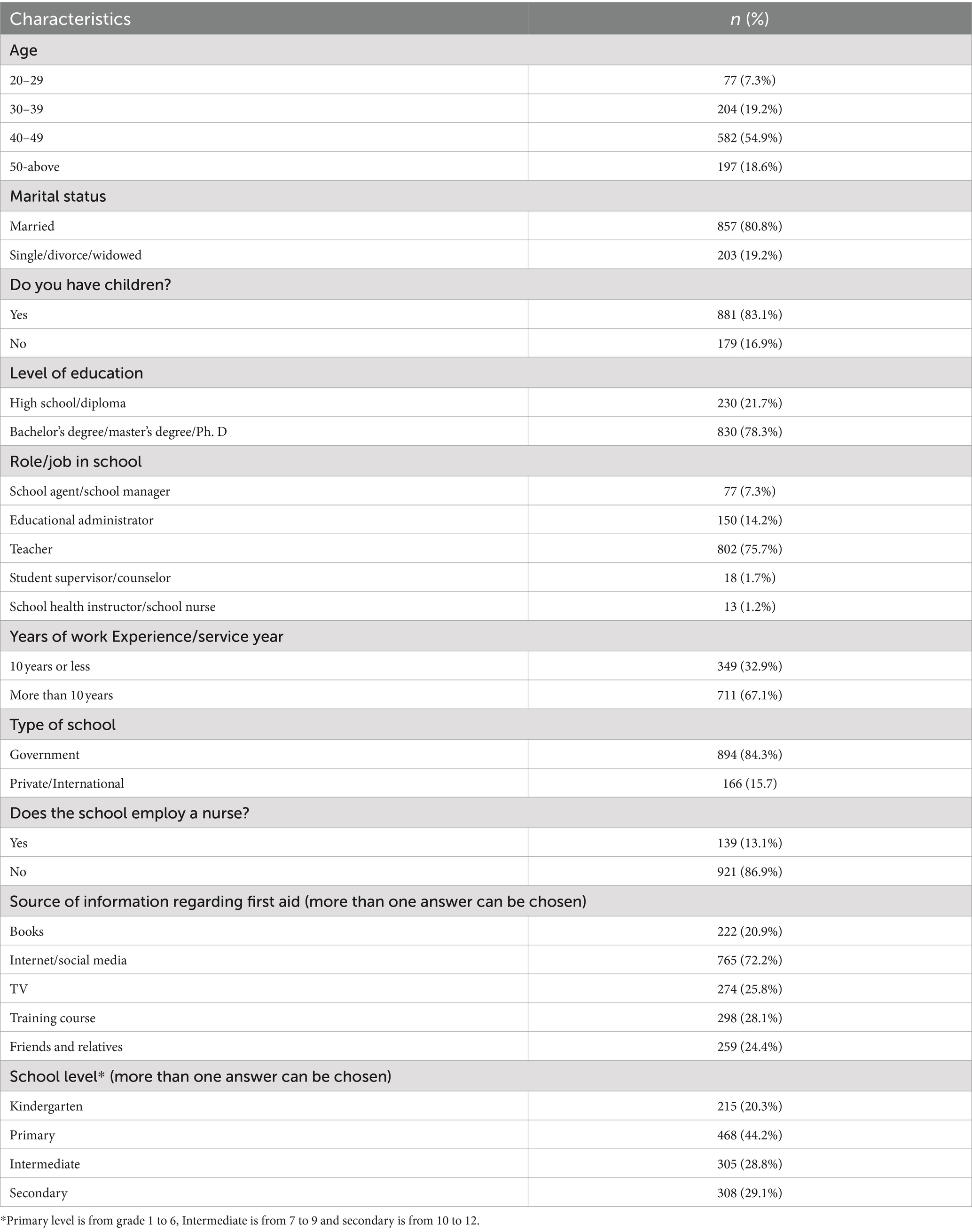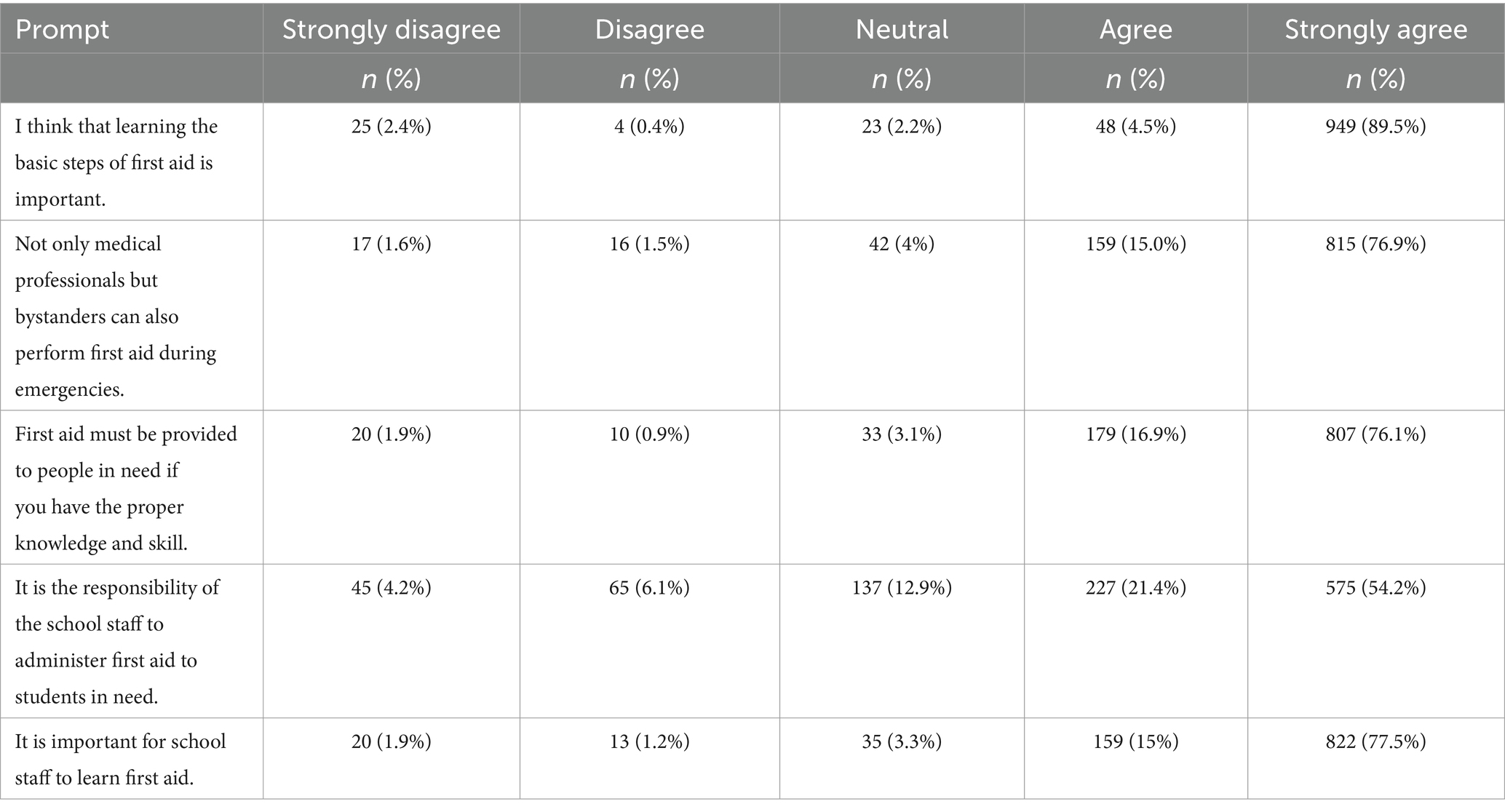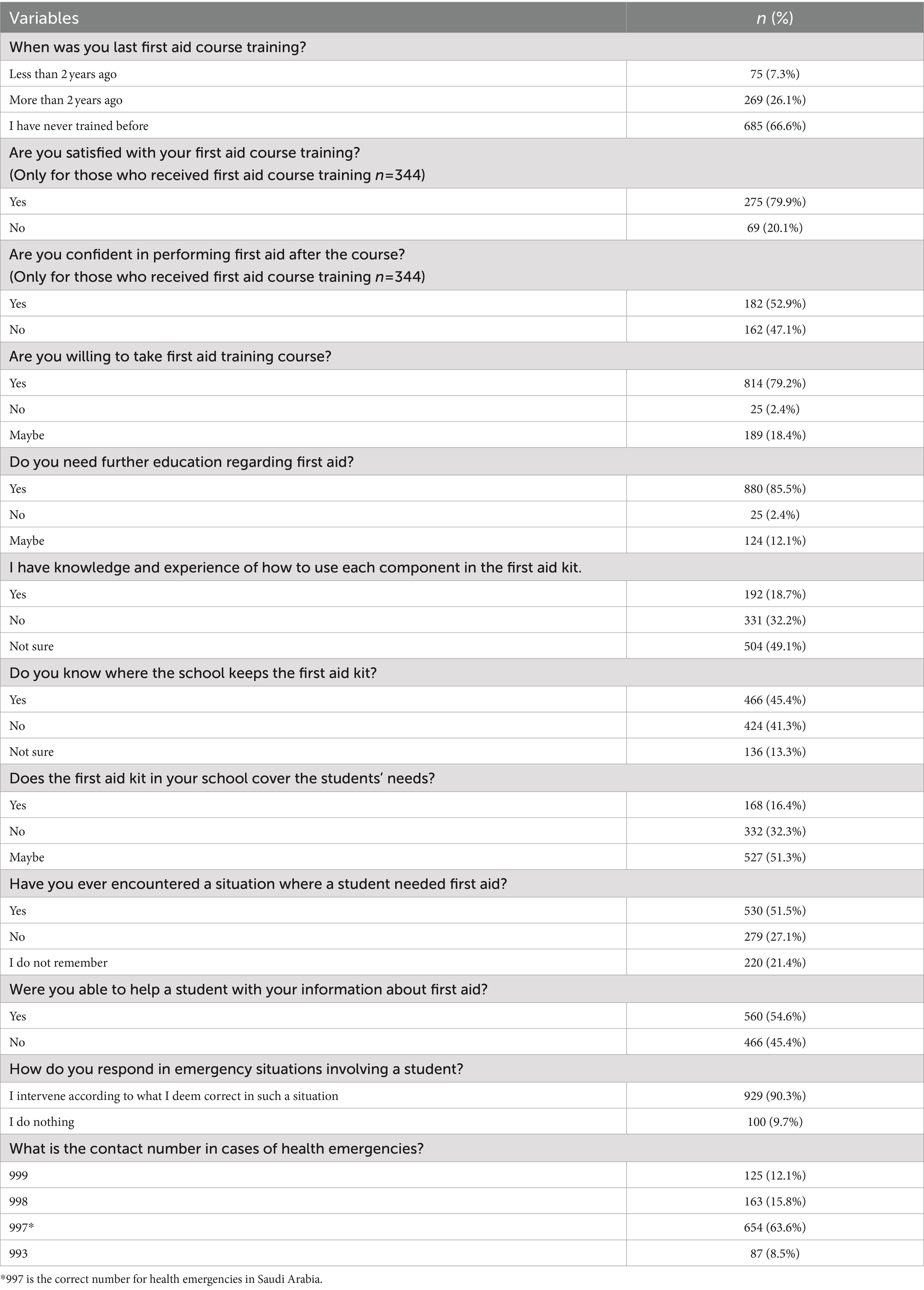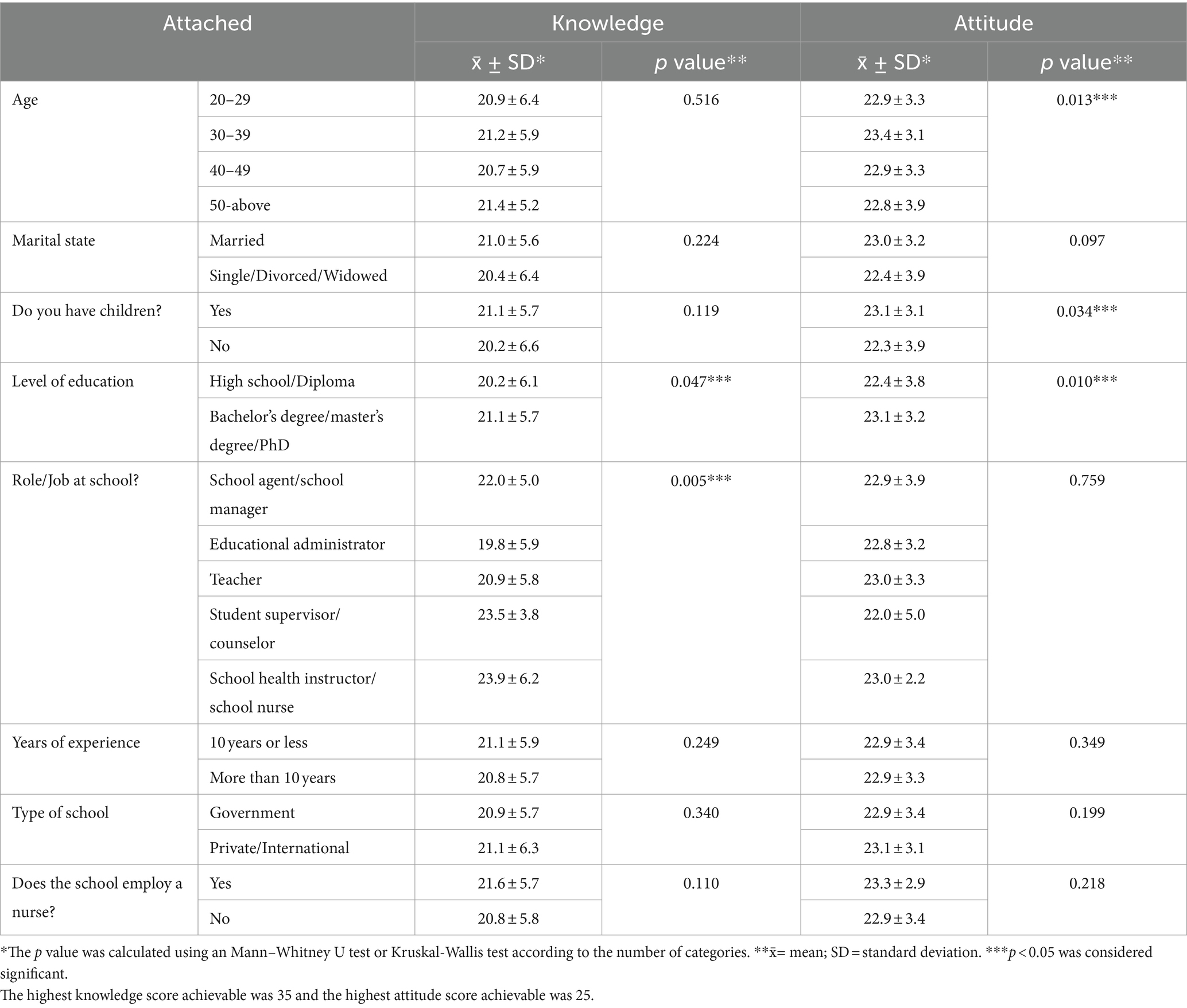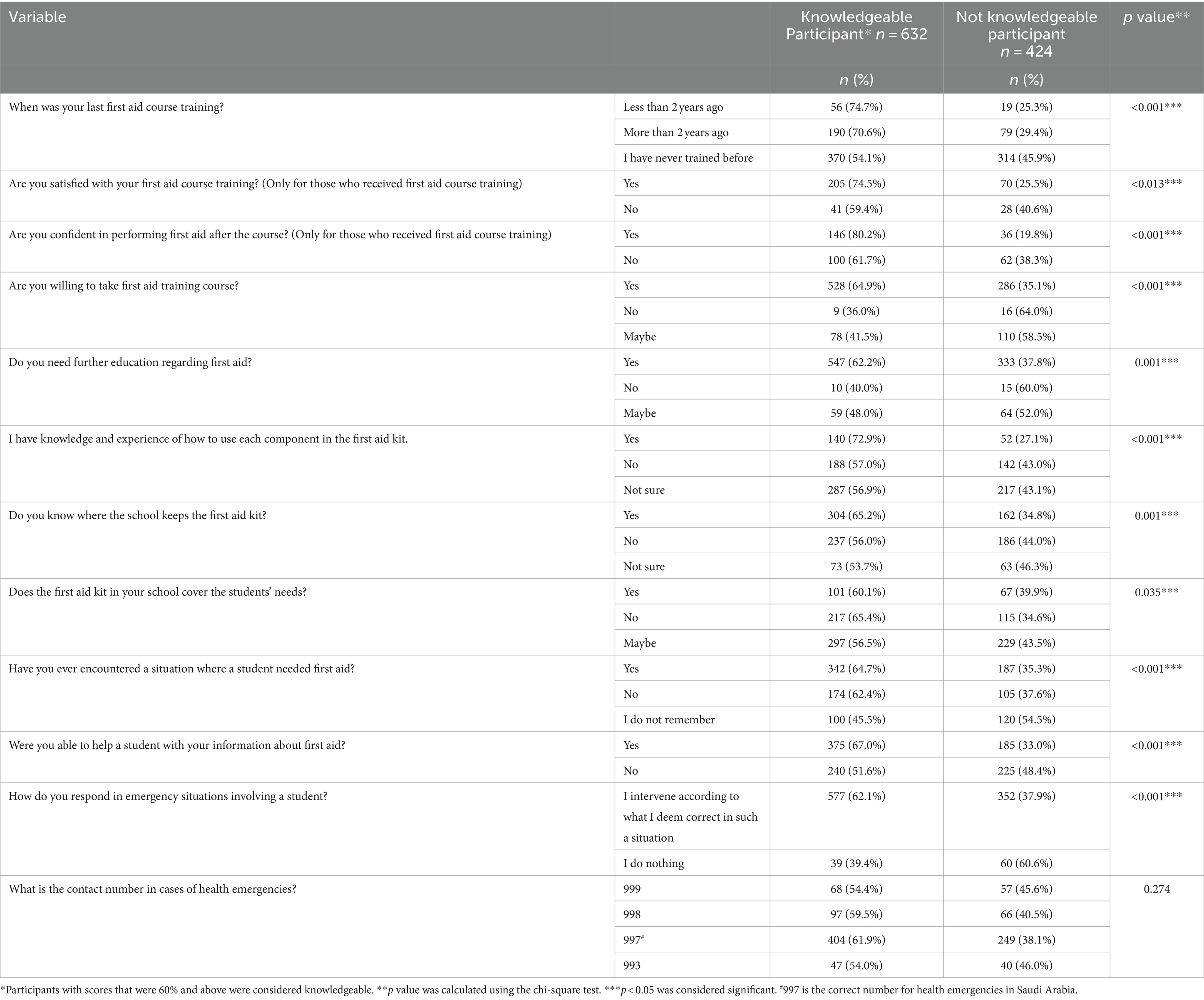- 1Department of Internal Medicine, College of Medicine, Princess Nourah Bint Abdulrahman University, Riyadh, Saudi Arabia
- 2Department of Family and Community Medicine, College of Medicine, Princess Nourah Bint Abdulrahman University, Riyadh, Saudi Arabia
- 3College of Medicine, Princess Nourah Bint Abdulrahman University, Riyadh, Saudi Arabia
Objectives: School-age children are constantly at risk of unintentional injuries. School educational staff are the primary group responsible for maintaining student welfare and responding to emergency situations. The present study aims to evaluate the knowledge and attitudes, practice level, and contextual factors related to first aid among female educational staff in Riyadh, Saudi Arabia.
Methods: A cross-sectional study was conducted with a convenience sampling of 1,060 female school staff at all educational levels in Riyadh. Participants completed a self-administered online questionnaire that contained items assessing sociodemographic data, knowledge, attitudes, and practice regarding first aid.
Results: Most of the 1,060 participants reported above average knowledge level, with a mean score of 21 (max 35). On the other hand, positive attitude toward first aid was high (μ = 22.9; max 25). Approximately 33.4% of staff had previous first aid training, and 79.2% were willing to participate in future trainings. First aid knowledge was highest for choking and lowest for seizures.
Conclusion: The attitudes toward first aid were generally positive, and the knowledge of first aid was above average among most participants but still unsatisfactory. Mandatory first aid courses are necessary to support children’s health during their education.
Introduction
First aid encompasses the initiated behaviors aimed at quickly resolving an acute illness or injury, relieving pain, and promoting recovery (1). Awareness toward first aid is essential to achieve solutions in case of accidents, but effective prevention and treatment of injuries first requires sufficient knowledge of first aid (2).
Accidental injuries can occur anywhere and at any time; however, in the case of children, many spend a substantial portion of their time at school. Some children may have health conditions such as epilepsy, asthma, and diabetes which are susceptible to worsening during their time at school (3). In addition, some emergency situations, such as hot weather and crowded environments, put children at risk of serious condition like heat stroke and syncope (4).
A study on French schoolchildren found that 52.8% of injuries occurred during physical activity, and 12.7% during school breaks (5). When a child experiences a sudden accidental injury during school, teachers and school instructors are the first to respond to the situation. Therefore, teachers and school instructors’ knowledge of first aid and its practice plays a significant role in preventing further injuries, complications from the injury, and even death (4).
In Saudi Arabia, approximately 41,561 fracture cases, 779 burn cases, 467 asphyxia cases, and 30,263 neck and back injuries were reported in schools in 2016 (6). A study conducted in 2019 assessing knowledge about first aid among male school teachers in Riyadh City found that only 14.9% of the study sample (436 participants) had good knowledge of first aid (defined as a score of 60% or higher) (7). Another study conducted in 2015 among Khamis Mushayt City secondary school teachers, which includes males and female teachers, found that only 19.6% of the 250 study participants were found to be knowledgeable about first aid (8). A more recent study conducted in 2021 in Hail City found 90.9% of male school teachers knew about first aid (6). However, the teachers’ attitude toward and practice of first aid have not been well reported in the aforementioned studies conducted in Saudi Arabia.
Few studies in Saudi Arabia have assessed school staff members’ knowledge of, attitudes toward, and practice of first aid, especially focusing on female staff members. This study aimed to investigate the level of knowledge, attitude toward, and practice of first aid among female school staff of all educational levels in Riyadh, Saudi Arabia. We also examined the factors affecting the level of knowledge of and attitude toward first aid among female school staff members.
Methods
This was a cross-sectional online self-administered questionnaire-based study. A Research Electronic Data Capture (REDCap) tool – a secure web-based software platform designed to support data capture in research studies – was used to create the questionnaire and collect data from female school staff. This tool was hosted by Princess Nourah bint Abdulrahman University (PNU) (9). Questions regarding knowledge of, attitude toward, and practice of first aid were adopted and modified from previous studies (2–4, 6–8, 10–12). The questionnaire underwent face and content validity tests and was then tested in a pilot testing before use. The questionnaire included the following four sections:
1. Sociodemographic data, which included information on the staff’s age, marital status, level of education, years of working experience, type and level of school in which they were employed, and sources of first aid information.
2. Knowledge, which included seven sections designed to assess female school staff’s knowledge of first aid in seven different emergency situations: fainting, choking, epistaxis, seizure, difficulty in breathing, stabbing, and heat stroke. Each emergency situation had five questions with “true”/“false”/“I do not know” responses that assessed the staff’s knowledge of dealing with these situations. Each correct response was given one point for a total of 35 questions. Participants with scores that were 60% and above were considered knowledgeable.
3. Attitudes consisted of five questions that measured the school staff’s attitude toward first aid and their behaviors in such situations. Participants were asked to rate their agreement on a five-point Likert scale ranging from “strongly agree” to “strongly disagree.” For each question, a score of 5 was given for responses that showed strong agreement and a score of 1 was given for responses that indicated strong disagreement. The total number of points achievable was 25.
4. First aid practice consisted of 12 items measuring female educators’ practice of first aid. These items included statements that measured their readiness using yes, no, or neutral responses, such as, for example, maybe, I do not know, or not sure, depending on the question.
Statistical analysis
All statistical analyses were conducted using SPSS software. The data management and analysis plan included descriptive statistics such as mean, standard deviation, frequencies, and percentages, which were used to describe the characteristics of the study sample. Quantitative data were analyzed using the t-test and one-way analysis of variance if normally distributed and using Mann–Whitney U test and Kruskal-Wallis test if not normally distributed, whereas the association of qualitative variables was analyzed using the chi-square test. Statistical significance was set at p < 0.05.
Sample size
The sample size was calculated using Raosoft software using a 95% confidence level with an estimated 50% response distribution and a margin of error of ±5%. The minimum recommended sample size returned was 1,011. Assuming 5% of all participants will submit incomplete responses to the online survey, an additional 5% participants were added to the target samples size, yielding 1,062 as the target sample size.
Sampling technique
Convenience sampling was performed by contacting those working in the education field through WhatsApp and encouraging them to pass it to others in the field until the required sample size was reached.
Ethical considerations
Prior to data collection, approval was obtained from the Institutional Review Board of Princess Nourah Bint Abdulrahman University (PNU), Riyadh, Saudi Arabia (IRB log number: 22–1044). All the participants voluntarily participated in the study after receiving a clear description of the study objectives through an electronic informed consent form. All the participants had the right to withdraw from the study at any time.
Results
We invited 1,670 educators to participate in the study, but we analysed only 1,060 responses after excluding those who declined to participate and incomplete responses. The relevant sociodemographic data is detailed in Table 1. Of the 1,060 participants, nearly half (582; 54.9%) were 40–49 years old, while 204 (19.2%) were 30–39 years old, 197 (18.6%) were 50 and above, and only 77 (7.3%) were 20–29 years old.
Most of the participants were married (857; 80.8%), had children (881; 83.1%), and had a bachelor’s degree or higher (830; 78.3%). Most participants were teachers (802; 75.7%), although educational administrators (150; 14.2%), school managers (77; 7.3%), student advisors (18; 1.7%), and school health instructors (13; 1.2%) also participated. At the school level, 29.1% of participants worked in high schools, 28.8% in secondary schools, 20.3% in kindergartens, and 44.2% worked in primary schools. Over half of the participants (711; 67.1%) had more than 10 years of experience in their role. Most of the participants (894; 84.3%) were from public schools and the vast majority (921; 86.9%) reported not having a nurse in their school.
Among all participants, 72.2% reported using the internet or social media to obtain information about first aid. Participants also reported getting first aid information from training courses (28.1%), through TV (25.8%), from friends and relatives (24.4%), and from books (20.9%).
The mean knowledge score regarding first aid was 21 out of 35 which is equivalent to 60%, with an SD of 16.7. The minimum percentage correct was zero and the maximum was 97.1% (Figure 1). Participants who scored 60% correct and above (n = 632; 59.6%) were considered knowledgeable. This study assessed the participants’ knowledge of various medical emergencies, including fainting, choking, epistaxis, seizures, difficulty breathing, stabbing, and heatstroke (Table 2). Among the emergency situations assessed, the mean knowledge score for choking was the highest at 3.5 ± 1.2, indicating that participants had the most knowledge about choking compared to the other emergencies. Conversely, seizure had the lowest mean score at 2.6 ± 1.2, suggesting that participants had the least knowledge about seizures.
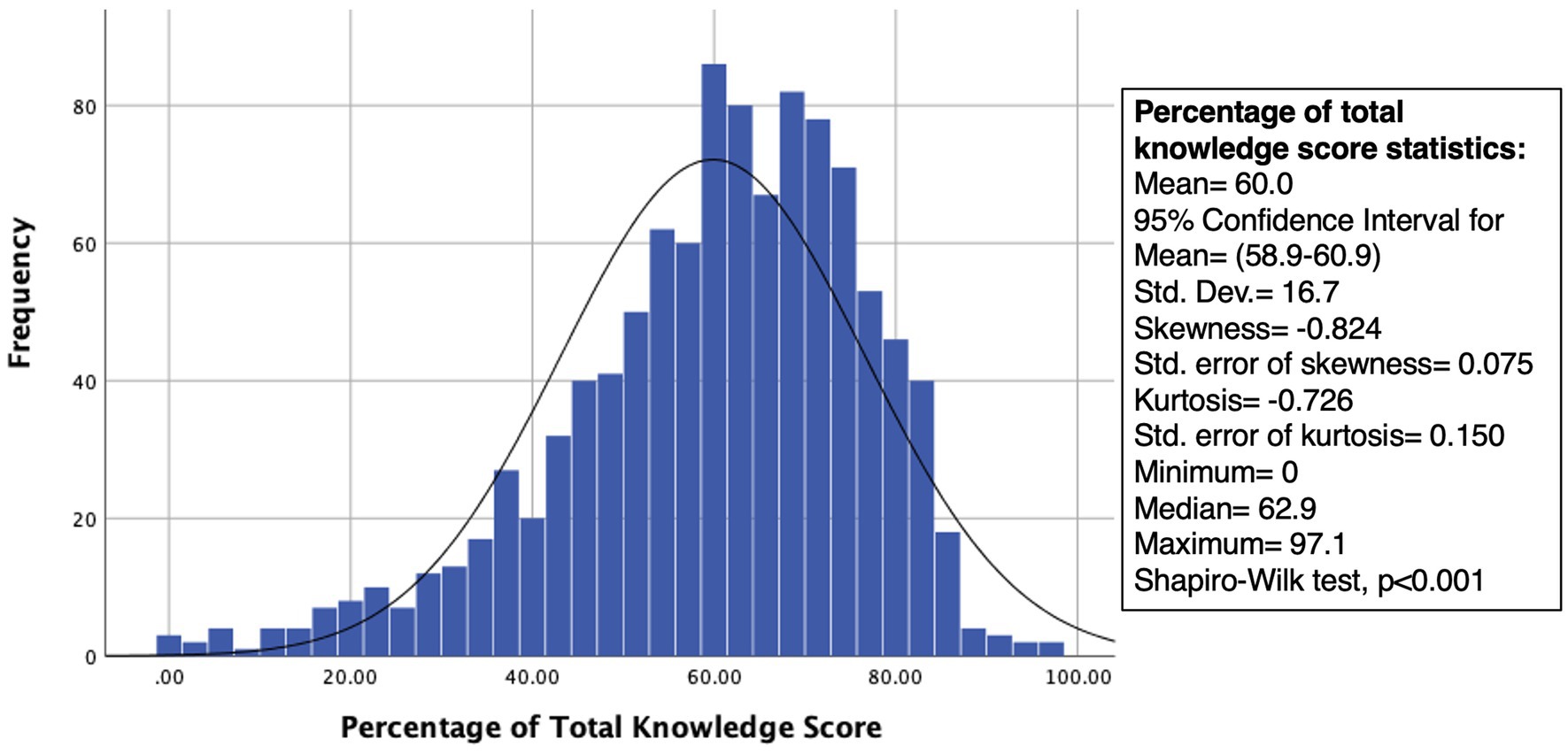
Figure 1. Frequency distribution of overall knowledge scores of female school educators in Saudi Arabia regarding first aid.
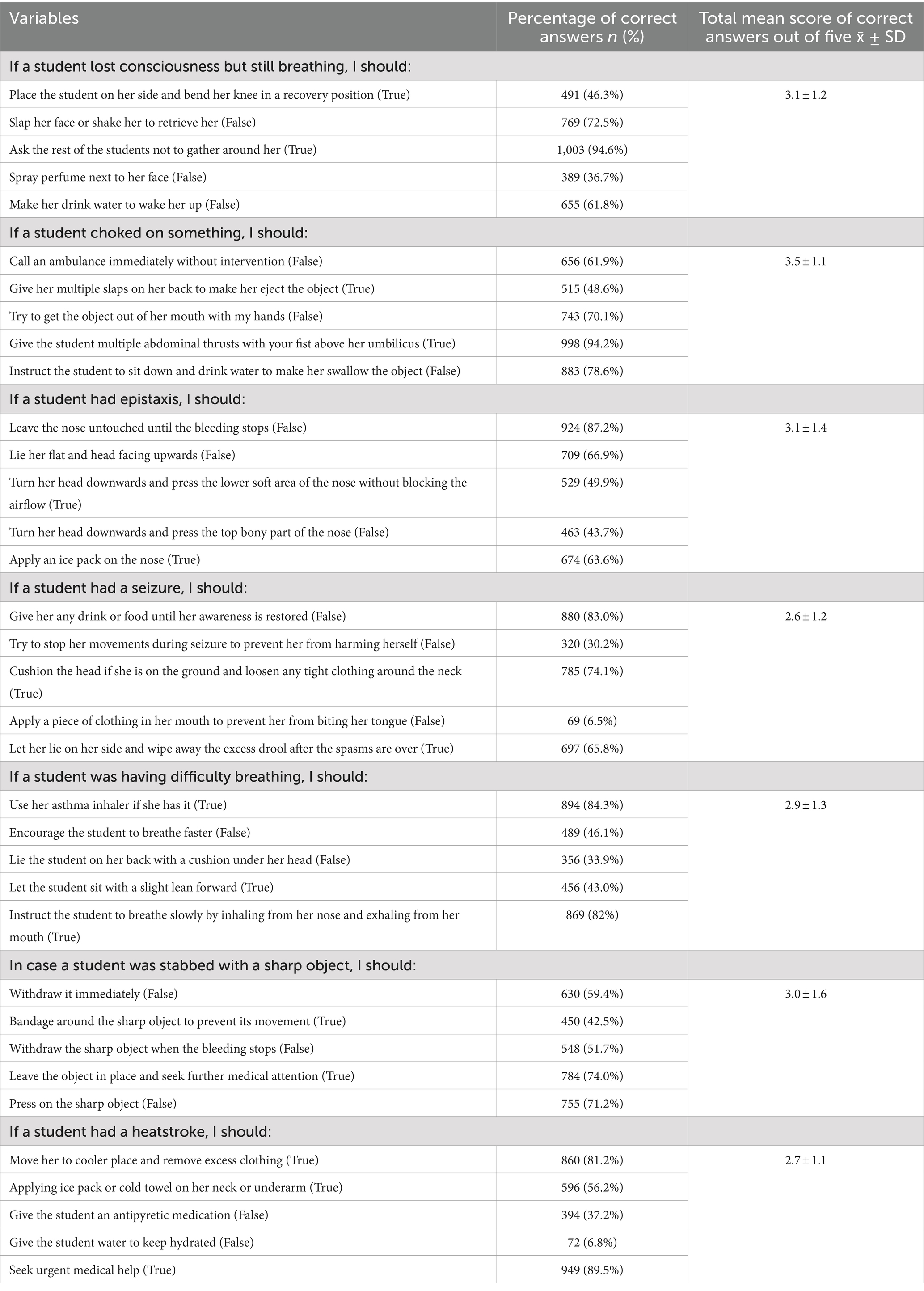
Table 2. The knowledge scores of the participants regarding first aid in different emergency situation.
As presented in Table 3, most participants showed a positive attitude toward learning first aid (about 89.5% of participants strongly agreed on the importance of learning the basics of first aid) and administering it (76% of participants strongly agreed with the idea that bystanders, and not just medical professionals, can perform first aid in case of emergencies). Approximately three quarters of the participants (76.1%) strongly agreed that if they had adequate first aid knowledge and skills, they would administer it to people in need. Around half (54.2%) of the participants strongly agreed and 21.4% agreed that providing first aid care to students in need was the responsibility of school staff. However, 4.2% strongly disagreed that school staff were responsible for providing first aid and 12.9% were neutral to the idea. Finally, 77.5% of the participants strongly agreed that learning first aid was important to them.
Table 4 displays the level of first aid practice reported by the participants. Nearly two thirds (66.6%) had no prior first aid training. Among those that reported prior first aid training, 7.3% participated in a first aid course within the previous 2 years, and 26.1% participated in first aid training more than 2 years ago. Of those with prior first aid training, 79.9% were satisfied with the course, and 52.9% reported feeling confident to give first aid after the course. Also, about 79.2% (n = 814) of the participants were willing to take a training course in first aid, while 85.5% reported needing further education regarding first aid. This willingness to take first aid training was significantly higher among those who aged between 40 and 49, had lower level of education and working in governmental schools.
Moreover, about half (49.1%) of the participants were not sure that they had the knowledge and experience of how to use each component in the first aid kit. However, 45.4% of the participants knew where the school stores the first aid kit, and nearly one sixth (16.4%) were certain that the first aid kit was sufficient.
In addition, 51.5% of the participants previously encountered an incident where a student at their school needed first aid, and 54.6% provided first aid to the student. Most of the participants (90.3%) did what they thought was correct when facing emergency situations involving a student, and more than half (63.6%) knew the correct number to contact in case of a health emergency.
Table 5 displays the knowledge and attitudes of the participants in relation to sociodemographic factors. Regarding the knowledge score, the highest level of knowledge of first aid was observed among health instructors/school nurses (23.9 ± 6.2; p = 0.005), in contrast to educational administers, who had the lowest scores (19.8 ± 5.9). Those with a bachelor’s degree, master’s degree, or PhD showed significantly higher levels of knowledge regarding first aid compared to those with a high school diploma or other diploma degrees (p = 0.047). The highest scores for knowledge was found in the group who had previously participated in a first aid training course (23.2 ± 5.4); the lowest scores were among those receiving information from friends and relatives (20.1 ± 5.8). Regarding school education level, the mean scores were approximately the same at each level. There were no statistically significant differences in the knowledge scores in terms of age, marital status, years of experience, type of school, or the presence of a nurse in the school in the study sample.
Regarding the scores for attitude toward first aid, there was a significant difference between age groups (p = 0.013), with the highest scores among those aged between 30 and 39 years. Participants were not significantly different depending on their marital status (p = 0.097). However, educational staff who were married had slightly higher attitude scores compared to their non-married counterparts. Having children was found to have a positive association with their attitude. This difference was statistically significant (p = 0.034). Those with bachelor’s degrees, master’s degrees, and PhD had more favorable attitudes toward first aid than those with high school diplomas and other diploma degrees (p = 0.010). School education level did not appear to be associated with the source of information regarding first aid. There were no statistically significant differences in the attitude score for this attribute according to role in school, years of experience, type of school, or whether the school had a nurse.
Table 6 displays the relationship between participants’ knowledge and practice level. There was a statistically significant difference between knowledge levels in participants who had received training less than 2 years prior (56; 74.7%) and those who had received it more than 2 years ago (190; 70.6%). Surprisingly, among those who had not received any training before, 54% could be considered knowledgeable. Also, the participants who were satisfied with their first aid course, had statistically significant better knowledge about first aid (205; 74.5%). Interestingly, we found that the participants who had more knowledge self-reported more willingness to take more first aid training (528; 64.9%) and reported needing more education regarding first aid (547; 62.2%). Most knowledgeable participants had faced a situation with a student who needed first aid and were able to appropriately manage the situation.
Discussion
First-aid awareness among school educational staff is crucial to help save children who face many injuries. This study assessed participants’ knowledge regarding first aid in various medical emergencies such as fainting, choking, epistaxis, seizures, difficulty in breathing, stabbing, and heat stroke. The overall mean knowledge score was above average, with an average score of 21.0 (n = 1,056). These findings were inconsistent with AlYahya et al. in 2019 (n = 436), whose study on male teachers showed a mean score below the average 10.63 out of 25 (41.4%). In the same study, those who scored 60% and above correct were only 14.9% of the study sample, while in the current study 59.6% of participants did so (7). This might be due to differences in the sample and in the knowledge assessment questions.
Notably, the highest score for knowledge of first aid was for responding to choking events, and the lowest mean score for knowledge was for responding to seizures. This might be explained by more frequent personal experiences with choking cases, considering its higher frequency among school-aged children. In contrast to the current study, a study in Jeddah, Saudi Arabia aimed to evaluate the knowledge of first aid in response to epilepsy and seizure among teachers at all educational levels, and found that most participants correctly answered questions assessing their responses during and after a seizure attack (10).
Despite their average knowledge, most participants showed a positive attitude toward learning and providing first aid. About 89.5% of participants strongly agreed on the importance of learning the basics of first aid; these results were in line with those of another study conducted on male schoolteachers (7). Moreover, the current study also showed that roughly two-thirds of the participants did not receive any first-aid training. This result was in line with AlYahya et al. (7) who showed that more than two-thirds of the male teachers did not take any previous first-aid training, indicating a shortage of first-aid courses in this region for both genders due to the lack of first-aid courses and not making them mandatory for the academic staff. The findings also revealed that the knowledge of participants who received recent training in the previous 2 years was significantly better than that of those who received training more than 2 years ago. Similarly, a study in South India showed an inverse relationship between knowledge of first aid and the number of years since receiving first aid training (11).
Moreover, when participants were asked about encountering situations requiring first aid intervention, more than one half reported facing such situations and the proportion of school staff who managed to help with their first aid knowledge was more than 50%. This suggests that most participants felt their first aid training allowed them to intervene positively when they encountered a situation that required first aid at their school. This is counter to what is observed elsewhere in the literature as a study conducted in Ethiopia found that the majority of kindergarten teachers were exposed to situations that required first-aid, but very few performed the required activity (2).
In a study in Riyadh, Saudi Arabia showed that 71.6% of the male teachers knew the phone number of the local Red Crescent, and these findings are in agreement with our findings in females (63.6%) (7).
Surprisingly, years of experience were found to have an inverse relationship with participants’ knowledge, as those with 10 or fewer years of experience had slightly better knowledge than participants with more than 10 years of experience. Although not significant, these unexpected results might be explained by the differences in the participants’ age, as those with more than 10 years’ experience are older and might have less motivation to take first aid training. These findings contrast with those of previous studies, which revealed that those with more years of experience showed better knowledge levels than those with less years of experience (2, 7).
In our findings regarding the type of school in which the participants worked, the private, international and governmental school educators had no significant difference in their knowledge. This finding is not in agreement with the results of previous studies where the knowledge was better in private and international schools (2, 12).
In the current study, most of the participants’ main sources of information were the internet and social media. However, those who obtained information regarding first aid from formal course training had greater knowledge than those who received it from other sources. These findings were partially supported by Ganfure et al. (2), who found that teachers who gained information about first aid from health professionals and health institutes were twice as knowledgeable as those who received it from other sources.
The current study also showed that having a positive attitude toward first aid was not affected by participants’ years of experience with similar attitude scores for those with more than 10 years of experience compared to those with 10 years or fewer. This was in contrast to the Ganfure et al. (2) study, where the positive attitudes toward first aid of kindergarten teachers who had 5–10 years and more than 10 years of experience were five and four times higher, respectively, than that of teachers who worked for less than 5 years. These variations could be due to differences in school setups, sociodemographic characteristics of both samples, or differences in measurements.
Our study also demonstrated that participants with higher level of education showed higher score in knowledge and a more favorable attitude toward first aid. Also, those working as students’ supervisor/counselor, school health instructor or school nurse had the highest knowledge scores. In AlYahya et al. (7), they reported that the knowledge of first aid was not significantly better among teachers who had a higher educational level.
Conclusion
This study indicated an acceptable level of first aid knowledge among most school staff. School staff’s knowledge was affected by their job in the school, their level of education and if they previously faced a situation that needed first aid use. We found that there was a positive attitude among school staff regarding first aid, especially among those who had children, had higher level of education or faced a situation that needed first aid use. There is a need for further and continuous training because nearly two-thirds of the participants had not been trained before in first aid, and the knowledge scores for first aid were higher among those who took first aid training less than 2 years ago.
Limitations
This study has several limitations. First, as the survey was distributed online though a convenient sampling technique, it is possible that the sample does not represent the entire population of the school staff. Our study was conducted only with female participants, which may limit the generalizability of the study to male educators.
Another limitation of our study is that it was a questionnaire-based study; therefore, we could not evaluate the actual practice level of the participants. Further studies are required to address this issue. The lack of sufficiently similar studies conducted in the same region limits comparisons with other studies. However, this study will be helpful for the Ministry of Health and Education when planning first-aid courses for school staff.
Recommendations
Based on our results, we recommend a first aid training course for educators every 2 years. The content of the course should cover all the aspects of first aid mentioned in this study which includes fainting, choking, epistaxis, seizure, difficulty in breathing, stabbing, and heat stroke. The current study’s knowledge questions can be used as a pre-post questionnaire or a written assessment method for the trainees after finishing the course in addition to a practical assessment method to evaluate their skills.
We also recommend further investigation to evaluate the practice level of first aid by conducting actual first aid skills assessment in school educational staff. In addition, we recommend the evaluation of the impact of different types of first aid training through intervention studies. Moreover, we suggest coordination between the Ministry of Health and Ministry of Education to train school staff and improve their skills in first aid response and emergency cases. Furthermore, we propose attracting qualified teachers to work as health educators in schools, setting up first-aid training programs, and providing staff with certificates of complement and rewards for their excellence.
Data availability statement
The raw data supporting the conclusions of this article will be made available by the authors, without undue reservation.
Ethics statement
The studies involving humans were approved by Princess Nourah bint Abdulrahman University Institutional Review Board. The studies were conducted in accordance with the local legislation and institutional requirements. The participants provided their written informed consent to participate in this study.
Author contributions
DA: Writing – review & editing, Writing – original draft, Validation, Supervision, Project administration, Methodology, Data curation, Conceptualization. NAle: Writing – review & editing, Writing – original draft, Validation, Supervision, Software, Project administration, Methodology, Funding acquisition, Formal analysis, Data curation. HA: Writing – original draft, Software, Methodology, Investigation, Formal analysis, Data curation, Conceptualization. FA: Writing – original draft, Software, Methodology, Investigation, Formal analysis, Data curation, Conceptualization. TA: Writing – original draft, Software, Methodology, Investigation, Formal analysis, Data curation, Conceptualization. NAlr: Writing – original draft, Software, Methodology, Investigation, Formal analysis, Data curation, Conceptualization. RndA: Writing – original draft, Software, Methodology, Investigation, Formal analysis, Data curation, Conceptualization. SAlt: Writing – original draft, Software, Methodology, Investigation, Formal analysis, Data curation, Conceptualization. SAls: Formal analysis, Data curation, Conceptualization, Writing – original draft, Software, Methodology, Investigation. RahA: Writing – original draft, Software, Methodology, Investigation, Formal analysis, Data curation, Conceptualization. RagA: Writing – original draft, Software, Methodology, Investigation, Formal analysis, Data curation, Conceptualization. JI: Writing – original draft, Software, Methodology, Investigation, Formal analysis, Data curation, Conceptualization. YA: Writing – original draft, Software, Methodology, Investigation, Formal analysis, Data curation, Conceptualization.
Funding
The author(s) declare that financial support was received for the research, authorship, and/or publication of this article. Princess Nourah bint Abdulrahman University Researchers Supporting Project number (PNURSP2024R469), Princess Nourah bint Abdulrahman University, Riyadh, Saudi Arabia.
Acknowledgments
We would like to extend our gratitude to Prof. Amel Fayed for the help during all the steps of this research.
Conflict of interest
The authors declare that the research was conducted in the absence of any commercial or financial relationships that could be construed as a potential conflict of interest.
Publisher’s note
All claims expressed in this article are solely those of the authors and do not necessarily represent those of their affiliated organizations, or those of the publisher, the editors and the reviewers. Any product that may be evaluated in this article, or claim that may be made by its manufacturer, is not guaranteed or endorsed by the publisher.
References
1. Zideman, DA, De Buck, EDJ, Singletary, EM, Cassan, P, Chalkias, AF, Evans, TR, et al. European resuscitation council guidelines for resuscitation 2015 section 9. First Aid Resusc. (2015) 95:278–87. doi: 10.1016/j.resuscitation.2015.07.031
2. Ganfure, G, Ameya, G, Tamirat, A, Lencha, B, and Bikila, D. First aid knowledge, attitude, practice, and associated factors among kindergarten teachers of Lideta sub-city Addis Ababa, Ethiopia. PLOS ONE. (2018) 13:e0194263. doi: 10.1371/journal.pone.0194263
3. Sharma, R, Kumar, A, and Masih, S. Knowledge and practice of primary school teachers about first aid management of selected minor injuries among children. Int J Med Public Health. (2014) 4:458. doi: 10.4103/2230-8598.144114
4. Bakalarski, P, Chavada, P, Mazet, G, Combes, D, and Dekesel, B. Assessment of teachers’ knowledge about first aid. Crit Care Innov. (2020) 3:18–23. doi: 10.32114/CCI.2020.3.1.18.23
5. Sapien, RE, and Allen, A. Emergency preparation in schools: a snapshot of a rural state. Pediatr Emerg Care. (2001) 17:329–33. doi: 10.1097/00006565-200110000-00003
6. Alshammari, KO. Assessment of knowledge, attitude, and practice about first aid among male school teachers in hail city. J Family Med Prim Care. (2021) 10:138–42. doi: 10.4103/jfmpc.jfmpc_1322_20
7. AlYahya, IA, Almohsen, HA, AlSaleem, IA, Al-Hamid, MM, Arafah, AM, Al Turki, YA, et al. Assessment of knowledge, attitude, and practice about first aid among male school teachers and administrators in Riyadh, Saudi Arabia. J Family Med Prim Care. (2019) 8:684–8. doi: 10.4103/jfmpc.jfmpc_316_18
8. Al Gharsan, M, and Alarfaj, I. Knowledge and practice of secondary school teachers about first aid. J Family Med Prim Care. (2019) 8:1587–93. doi: 10.4103/jfmpc.jfmpc_76_19
9. Harris, PA, Taylor, R, Minor, BL, Elliott, V, Fernandez, M, O’Neal, L, et al. The REDCap consortium: building an international community of software platform partners. J Biomed Inform. (2019) 95:103208. doi: 10.1016/j.jbi.2019.103208
10. Kanjo, M, Najjar, A, Bokhari, AY, Alqarni, GA, Darwesh, EA, and Alqarni, GS. Knowledge of epilepsy and seizure first aid among teachers in Jeddah, Saudi Arabia Epilepsy. Behav Rep. (2021) 16:100475. doi: 10.1016/j.ebr.2021.100475
11. Joseph, N, Narayanan, T, Bin Zakaria, S, Nair, AV, Belayutham, L, Subramanian, AM, et al. Awareness, attitudes and practices of first aid among school teachers in Mangalore, South India. J Prim Health Care. (2015) 7:274–81. doi: 10.1071/hc15274
Keywords: first aid, school, Saudi Arabia (KSA), knowledge, awarenes, school health (MeSH)
Citation: Abdelrahman D, Aleyeidi NA, Alqahtani HT, Aldosari FN, Al Shammari TG, Alrusaini NK, Almahfouz RF, Altamimi SA, Alshehri SA, Alsubaie RM, Almuzaini RA, Innab JA and Alsuhaibani YA (2024) Assessment of knowledge, attitude, and practice toward first aid among female school educators in Riyadh, Saudi Arabia: a cross-sectional study. Front. Public Health. 12:1482181. doi: 10.3389/fpubh.2024.1482181
Edited by:
Michal Grivna, United Arab Emirates University, United Arab EmiratesReviewed by:
Heather T. Essigmann, University of Texas Health Science Center at Houston, United StatesChalachew Yenew, Debre Tabor University, Ethiopia
Copyright © 2024 Abdelrahman, Aleyeidi, Alqahtani, Aldosari, Al Shammari, Alrusaini, Almahfouz, Altamimi, Alshehri, Alsubaie, Almuzaini, Innab and Alsuhaibani. This is an open-access article distributed under the terms of the Creative Commons Attribution License (CC BY). The use, distribution or reproduction in other forums is permitted, provided the original author(s) and the copyright owner(s) are credited and that the original publication in this journal is cited, in accordance with accepted academic practice. No use, distribution or reproduction is permitted which does not comply with these terms.
*Correspondence: Nouran Abdullah Aleyeidi, bmFhbGV5ZWlkaUBwbnUuZWR1LnNh
 Doaa Abdelrahman
Doaa Abdelrahman Nouran Abdullah Aleyeidi
Nouran Abdullah Aleyeidi Huda Turki Alqahtani
Huda Turki Alqahtani Falak Nasser Aldosari
Falak Nasser Aldosari Tmadher Ghanam Al Shammari
Tmadher Ghanam Al Shammari Norah Khalid Alrusaini
Norah Khalid Alrusaini Rnda Fahad Almahfouz
Rnda Fahad Almahfouz Sarah Ali Altamimi
Sarah Ali Altamimi Shatha Abdulwahab Alshehri
Shatha Abdulwahab Alshehri Rahaf Muqbel Alsubaie
Rahaf Muqbel Alsubaie Raghad Abdulrahman Almuzaini
Raghad Abdulrahman Almuzaini Jazil Abdulrahman Innab
Jazil Abdulrahman Innab Yara Abdulaziz Alsuhaibani
Yara Abdulaziz Alsuhaibani